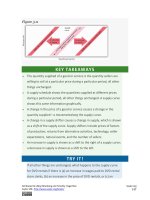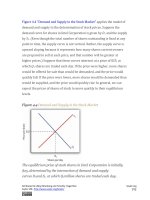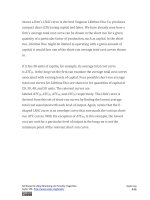Authors libby rittenberg 407
Bạn đang xem bản rút gọn của tài liệu. Xem và tải ngay bản đầy đủ của tài liệu tại đây (421.65 KB, 1 trang )
Quantity TUX MUX MUX/PX TUY MUY MUY/PY
8
229
260
9
241
276
1. Fill in the other columns of the table by calculating the
marginal utilities for goods X and Y and the ratios of marginal
utilities to price for the two goods. Assume that the price of
both goods X and Y is $3. Be sure to use the “midpoint
convention” when you fill out the table.
2. If Jeremy allocates $30 to spend on both goods, how many
units will he buy of each?
3. How much will Jeremy spend on each good at the utility
maximizing combination?
4. How much total utility will Jeremy experience by buying the
utility-maximizing combination?
5. Suppose the price of good Y increases to $6. How many units
of X and Y will he buy to maximize his utility now?
6. Draw Jeremy’s demand curve for good Y between the prices
of $6 and $3.
6. Sid is a commuter-student at his college. During the day, he
snacks on cartons of yogurt and the “house special” sandwiches
at the Student Center cafeteria. A carton of yogurt costs $1.20;
the Student Center often offers specials on the sandwiches, so
their price varies a great deal. Sid has a budget of $36 per week
for food at the Center. Five of Sid’s indifference curves are given
by the schedule below; the points listed in the tables correspond
to the points shown in the graph.
Attributed to Libby Rittenberg and Timothy Tregarthen
Saylor URL: />
Saylor.org
407









